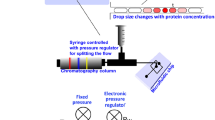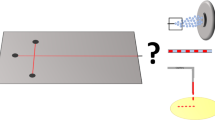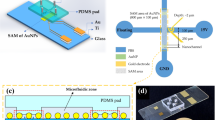Abstract
Microfluidic chips combined with surface-enhanced Raman spectroscopy (SERS) offer an outstanding platform for rapid and high-sensitivity chemical analysis. However, it is nontrivial to conveniently form nanoparticle aggregrates (as SERS-active spots for SERS detection) in microchannels in a well-controlled manner. Here, we present a rapid, highly sensitive and label-free analytical technique for determining bovine serum albumin (BSA) on a poly(dimethylsiloxane) (PDMS) microfluidic chip using SERS. A modified PDMS pneumatic valve and nanopost arrays at the bottom of the fluidic microchannel are used for reversibly trapping gold nanoparticles to form gold aggregates, creating SERS-active spots for Raman detection. We fabricated a chip that consisted of a T-shaped fluidic channel and two modified pneumatic valves, which was suitable for fast loading of samples. Quantitative analysis of BSA is demonstrated with the measured peak intensity at 1,615 cm−1 in the surface-enhanced Raman spectra. With our microfluidic chip, the detection limit of Raman can reach as low as the picomolar level, comparable to that of normal mass spectrometry.

A convenient strategy for rapid formation of gold nanoparticle aggregates on microfluidic chips was developed. A modified poly(dimethylsiloxane) pneumatic valve and nanopost arrays at the bottom of the fluidic microchannel were used for reversibly trapping gold nanoparticles to form gold aggregates, creating SERS-active spots for sensitive surface-enhanced Raman spectroscopy detection. The detection limit of Raman can reach as low as the picomolar level with our microfluidic chip.






Similar content being viewed by others
References
Whitesides GM (2006) The origins and the future of microfluidics. Nature 442:368–373
Yager P, Edwards T, Fu E, Helton K, Nelson K, Tam MR, Weigl BH (2006) Microfluidic diagnostic technologies for global public health. Nature 442:412–418
Weibel DB, Whitesides GM (2006) Applications of microfluidics in chemical biology. Curr Opin Cell Biol 10:584–591
Huang B, Wu HK, Bhaya D, Grossman A, Granier S, Kobilka BK, Zare RN (2007) Counting low-copy number protiens in a single cell. Science 315:81–84
Rios A, Escarpa A, González MC, Crevillén AG (2006) Challenges of analytical microsystems. TrAC Trends Anal Chem 25:467–479
Mogensen KB, Klank H, Kutter JP (2004) Recent developments in detection for microfluidic systems. Electrophoresis 25:3498–3512
Schwarz MA, Hauser PC (2001) Recent developments in detection methods for microfabricated analytical devices. Lab Chip 1:1–6
Viskari PJ, Landers JP (2006) Unconventional detection methods for microfluidic devices. Electrophoresis 27:1797–1810
Dittrich PS, Manz A (2005) Single-molecule fluorescence detection in microfluidic channels—the Holy Grail in μTAS? Anal Bioanal Chem 382:1771–1782
Haynes CL, Yonzon CR, Zhang XY, Van Duyne RP (2005) Surface-enhanced Raman sensors: early history and the development of sensors for quantitative biowarfare agent and glucose detection. J Raman Spectrosc 36:471–484
Faulds K, Littleford RE, Graham D, Dent G, Smith WE (2004) Comparison of surface-enhanced resonance Raman scattering from unaggregated and aggregated nanoparticles. Anal Chem 76:592–598
Hering K, Cialla D, Ackermann K, Dörfer T, Möller R, Schneidewind H, Mattheis R, Fritzsche W, Rösch P, Popp J (2008) SERS: a versatile tool in chemical and biochemical diagnostics. Anal Bioanal Chem 390:113–124
Popp J, Mayerhöfer T (2009) Surface-enhanced Raman spectroscopy. Anal Bioanal Chem 394:1717–1718
Porter MD, Lipert RJ, Siperko LM, Wang GF, Narayanan R (2008) SERS as a bioassay platform: fundamentals, design, and applications. Chem Soc Rev 37:1001–1011
Moskovits M (1985) Surface-enhanced spectroscopy. Rev Mod Phys 57:783–828
Nie SM, Emory SR (1997) Probing single molecules and single nanoparticles by surface-enhanced Raman scattering. Science 275:1102–1106
Xu HX, Bjerneld EJ, Käll M, Börjesson L (1999) Spectroscopy of single hemoglobin molecules by surface enhanced Raman scattering. Phys Rev Lett 83:4357–4360
Schwartzberg AM, Grant CD, Wolcott A, Talley CE, Huser TR, Bogomolni R, Zhang JZ (2004) Unique gold nanoparticle aggregates as a highly active surface-enhanced Raman scattering substrate. J Phys Chem B 108:19191–19197
Han XG, Goebl J, Lu ZD, Yin YD (2011) Role of salt in the spontaneous assembly of charged gold nanoparticles in ethanol. Langmuir 27:5282–5289
Piorek BD, Lee SJ, Santiago JG, Moskovits M, Banerjee S, Meinha CD (2007) Free-surface microfluidic control of surface-enhanced Raman spectroscopy for the optimized detection of airborne molecules. Proc Natl Acad Sci USA 104:18898–18901
Cho H, Lee B, Liu GL, Agarwal A, Lee LP (2009) Label-free and highly sensitive biomolecular detection using SERS and electrokinetic preconcentration. Lab Chip 9:3360–3363
Lee S, Joo S, Park S, Kim S, Kim HC, Chung TD (2010) SERS decoding of micro gold shells moving in microfluidic systems. Electrophoresis 31:1623–1629
Cabalín LM, Rupérez A, Laserna JJ (1996) Flow-injection analysis and liquid chromatography: surface-enhanced Raman spectrometry detection by using a windowless flow cell. Anal Chim Acta 318:203–210
Park T, Lee S, Seong GH, Choo J, Lee EK, Kim YS, Ji WH, Hwang SY, Gweond D, Lee S (2005) Highly sensitive signal detection of duplex dye-labelled DNA oligonucleotides in a PDMS microfluidic chip: confocal surface-enhanced Raman spectroscopic study. Lab Chip 5:437–442
Ackermann KR, Henkel T, Popp J (2007) Quantitative online detection of low-concentrated drugs via a SERS microfluidic system. Chem Phys Chem 8:2665–2670
Tong LM, Righini M, Gonzalez MU, Quidant R, Käll M (2009) Optical aggregation of metal nanoparticles in a microfluidic channel for surface-enhanced Raman scattering analysis. Lab Chip 9:193–195
Wang M, Jing N, Chou IH, Coté GL, Kameoka J (2007) An optofluidic device for surface enhanced Raman spectroscopy. Lab Chip 7:630–632
Chou IH, Benford M, Beier HT, Coté GL, Wang M, Jing N, Kameoka J, Good TA (2008) Nanofluidic biosensing for β-amyloid detection using surface enhanced Raman spectroscopy. Nano Lett 8:1729–1735
Wang M, Benford M, Jing N, Coté G, Kameoka J (2009) Optofluidic device for ultra-sensitive detection of proteins using surface-enhanced Raman spectroscopy. Microfluid Nanofluid 6:411–417
Zhou JH, Yan H, Zheng YZ, Wu HK (2009) Highly fluorescent poly(dimethylsiloxane) for on-chip temperature measurements. Adv Funct Mater 19:324–329
Dai W, Zheng YZ, Luo KQ, Wu HK (2010) A prototypic microfluidic platform generating stepwise concentration gradients for real-time study of cell apoptosis. Biomicrofluidics 4:024101–024114
Wu HK, Huang B, Zare RN (2005) Construction of microfluidic chips using polydimethylsiloxane for adhesive bonding. Lab Chip 5:1393–1398
Unger MA, Chou HP, Thorsen T, Scherer A, Quake SR (2000) Monolithic microfabricated valves and pumps by multilayer soft lithography. Science 288:113–116
Zheng YZ, Dai W, Wu HK (2009) A screw-actuated pneumatic valve for portable, disposable microfluidics. Lab Chip 9:469–472
Zhang Q, Li WY, Moran C, Zeng J, Chen JY, Wen LP, Xia Y (2010) Seed-mediated synthesis of Ag nanocubes with controllable edge lengths in the range of 30–200 nm and comparison of their optical properties. J Am Chem Soc 132:11372–11378
Westcott SL, Oldenburg SJ, Lee TR, Halas NJ (1999) Construction of simple gold nanoparticle aggregates with controlled Plasmon–plasmon interactions. Chem Phys Lett 300:651–653
Bae SC, Lee H, Lin ZQ, Granick S (2005) Chemical imaging in a surface forces apparatus: confocal Raman spectroscopy of confined poly(dimethylsiloxane). Langmuir 21:5685–5688
Han XX, Zhao B, Ozaki Y (2009) Surface-enhanced Raman scattering for protein detection. Anal Bioanal Chem 394:1719–1727
Zhou DF, Ke WZ, Hang H, Kang JI (2006) Raman spectroscopic study on the influence of UV radiation on BSA. J Light Scatter 18:241–247
Bell SEJ, Sirimuthu NMS (2008) Quantitative surface-enhanced Raman spectroscopy. Chem Soc Rev 37:1012–1024
Bell SEJ, Mackle JN, Sirimuthu NMS (2005) Quantitative surface-enhanced Raman spectroscopy of dipicolinic acid-towards rapid anthrax endospore detection. Analyst 130:545–549
Choi I, Huh YS, Erickson D (2011) Size-selective concentration and label-free characterization of protein aggregates using a Raman active nanofluidic device. Lab Chip 11:632–638
Lee S, Choi J, Chen LX, Park B, Kyong JB, Seong GH, Choo J, Lee Y, Shin KH, Lee EK, Joo SW, Lee KH (2007) Fast and sensitive trace analysis of malachite green using a surface-enhanced Raman microfluidic sensor. Anal Chim Acta 590:139–144
Mulvihill M, Tao A, Benjauthrit K, Arnold J, Yang PD (2008) Surface-enhanced Raman spectroscopy for trace arsenic detection in contaminated water. Angew Chem Int Ed 47:6456–6460
Brewer SH, Glomm WR, Johnson MC, Knag MK, Franzen S (2005) Probing BSA binding to citrate-coated gold nanoparticles and surfaces. Langmuir 21:9303–9307
Faulds K, McKenzie F, Smith WE, Graham D (2007) Quantitative simultaneous multianalyte detection of DNA by dual-wavelength surface-enhanced resonance Raman scattering. Angew Chem Int Ed 46:1829–1831
Acknowledgments
We are grateful to Prof. Xiaoyuan Li (Department of Chemistry, The Hong Kong University of Science and Technology, Hong Kong) for allowing us to use their Raman instruments. This work was supported by the Hong Kong RGC (#605210).
Author information
Authors and Affiliations
Corresponding author
Electronic supplementary material
Below is the link to the electronic supplementary material.
ESM 1
(PDF 315 kb)
Rights and permissions
About this article
Cite this article
Zhou, J., Ren, K., Zhao, Y. et al. Convenient formation of nanoparticle aggregates on microfluidic chips for highly sensitive SERS detection of biomolecules. Anal Bioanal Chem 402, 1601–1609 (2012). https://doi.org/10.1007/s00216-011-5585-z
Received:
Revised:
Accepted:
Published:
Issue Date:
DOI: https://doi.org/10.1007/s00216-011-5585-z




